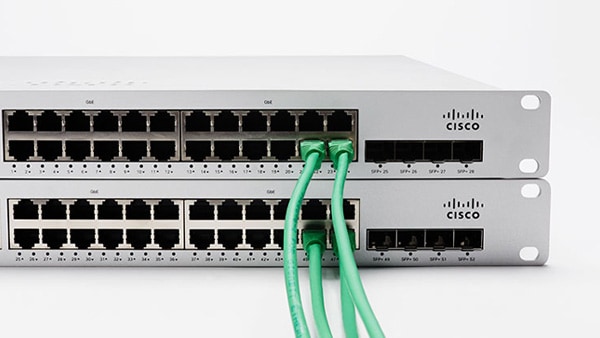SWITCHES
Network switch is an essential component of business network to connect Ethernet cables from a number of devices together. Apart from from network switch hub and router are all computer networking devices with varying characteristics and often interchangeably used by some technicians. Network switch is a small hardware device that filters and forwards packets between LAN segments. Difference models of network switch support various number of connected devices. Consumer-grade network switch provides either four or eight connection for Ethernet devices, while corporate network switch typically supports between 32 and 128 connections. Moreover, network switches can be additionally connected to each other that is regarded as a daisy chaining method to add a increasingly larger number of devices to a LAN.
In a network deployment, switch channels incoming data from any of multiple input ports to the specific output port that will take the data toward its intended destination.
Besides, to achieve high performance level there are different types of switches in networking, which are follows:
1. LAN Switches:- Local area network switches or LAN switches usually used to connect points on a company's internal LAN. It is also known as a data switch or an Ethernet switch. It blocks the overlap of data packets running through a network by the economical allocation of bandwidth. The LAN switch delivers the transmitted data packet before directing it to its planned receiver. These types of switches reduce network congestion or bottlenecks by distributing a package of data only to its recipient .
2. Unmanaged Switch:- Unmanaged network switches are frequently used in home networks, small companies and businesses. It permit devices on the network to connect with each other, such as computer to computer or printer to computer in one location. An unmanaged switch does not necessarily need to be configured or watched. It is simple and easy to set up. If you want to add more Ethernet ports, you can use these plug and play types of switches in networking.
Compare to unmanage switches, the advantage of managed switches is that the can be customized to enhanced the functionality of a certain network. They offer some feature like QoS( quality of service ), Simple network management protocol (SNMP) and so on. these type of switches in networking can support a range of advanced features designed to be controlled by a professional administrator. In addition there is smart switch type of managed switch. it has some features that managed switch has, but are more limited. Smart network switch is usually used for the networking devices such as VLANs.
3. PoE Switch:- PoE Gigabit Ethernet switch is a network switch that utilizes Power over Ethernet technology. When connected with multiple other network device, PoE switches can support power and data transmission over one network cable at the same time. this greatly simplifies the cabling process. These types of switches in networking provide greater flexibility and you will never have to worry about power outlet when deploying network devices.
FEATURES OF SWITCHES
Following are features of the network switches.
1. It operate at layer-2 ( data link layer ).
2. It is available in various configuration and as per data transfer speed such as 10/100/1000 Mbps or 10/100 Gbps.
3. Operates in full duplex mode.
4. Packet collision is avoided due to port to port data transmission.
ADVANTAGE OF SWITCHES
Following are benefits or advantage of switches
1. They increase the available bandwidth of the network.
2. they help to reducing workload on individual host PCs.
3. they increase the performance of he network .
4. Network which use switches will have less frame collision. This is due to the fact that switches create collision domain for each connection.
5. Switches can be connected directly to workstation.
DISADVANTAGE OF SWITCHES
Following are the disadvantage of switches:
1. they are more expensive compare to network bridges.
2. Network connectivity issues are difficult to be traced through the network switch.
3. Broadcast traffic may be troublesome.
4. If switches are in promiscuous mode, they are vulnerable o security attacks e.g. spoofing IP address or capturing of ethernet frames.
5. proper design and configuration is needed in order to handle multicast packets.
6. while limited broadcast, they are not as good as routers.





Comments
Post a Comment